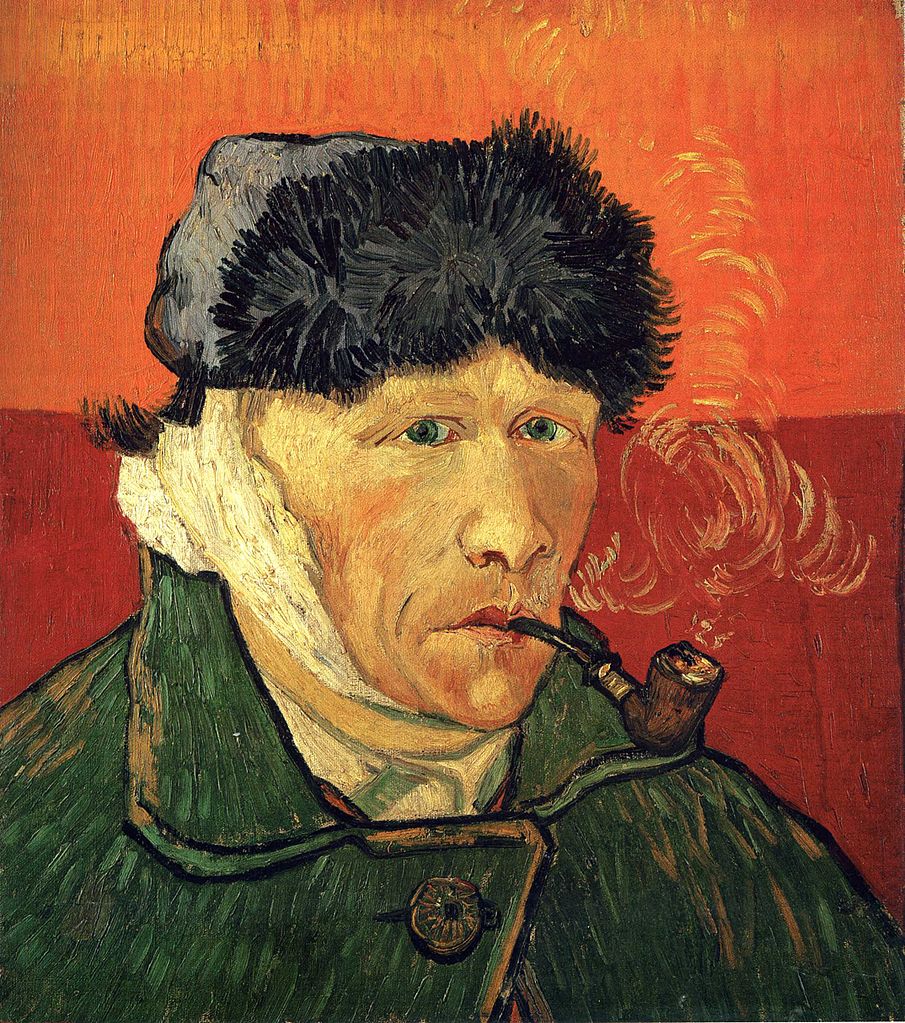Vincent Van Gogh was an admired artist, who was also a troubled and “tortured genius.” His artwork, Starry Night, Bedroom in Arles, and many others have earned him fame and recognition as one of the greatest artists of his time. But what many remember most about this artist is the story of his severed ear. Although his art is exemplary, his struggle with mental health and self-harm is admirable. His struggle was overlooked due to his incredible talent. He was successful as an art dealer, but as an artist, he had to prove himself with the headquarters of international art dealers, Gopil & Cie. During his lifetime, Van Gogh was the poster boy for the image of starving artist. His artwork was not recognized until much later in his career, which could have been a leading cause of his major depression and anxiety.1
Van Gogh, born in the Netherlands, decided to start his career in Paris in the 1880s, where many of the age’s great artists also resided. He believed he could get recognition for his pieces through his younger brother, Theo, who made his living as an art dealer. His brother introduced him to many artists, including Georges Seaurat, Camille Pisatto, and Paul Gauguin. Upon meeting these successful artists, Van Gogh was greatly inspired by their work and began creating his own artistic style, beginning in 1883. Later the same year, Van Gogh rented a small house in Arles, in the south of France. Paul Gauguin and Van Gogh became close friends and later roommates. They consistently bounced ideas off of each other and created a strong friendship.2

Like many friendships, theirs was rocky, and they found themselves drifting apart. Gauguin had moved on to a different artistic style and was exploring other ideas. Van Gogh at the time, had been reciprocating signs of depression and mental health issues, but at the time, these symptoms were considered normal. When Gauguin decided to explore other art spectrums, it involved moving out of the house he and Van Gogh shared. He broke the news to his roommate about his intentions, and this evidently this made Van Gogh go over the edge. He did not take the news lightly and both men began verbally arguing. Van Gogh had disappeared for a few hours and when he returned to confront Gauguin, he had a razor blade in hand threatening to hurt Gauguin.3
During the confrontation, however, Van Gogh was hesitant to hurt his friend and decided to turn the blade on himself and completely cut off his ear. Gauguin left him bleeding and alone. Van Gogh bandaged his head and began drowning himself in alcohol. During this episode, he walked out of his home and into the streets where he found a prostitute. The ear that he had severed off of himself had been neatly wrapped in a cloth; since Van Gogh was still heavily intoxicated, he decided to present this token to the prostitute. Patiently, she ran off and alerted the police about her encounter and they immediately rushed to his home.4
Shortly before Christmas Eve, Van Gogh was found by police in his bed, partially conscious and with major blood loss. Authorities rushed him to the hospital where he surprisingly recovered. Meanwhile, Gauguin was brought into questioning, but gave no testimony on the incident. It was believed that Van Gogh had suffered a severe mental breakdown long before he had severed his ear, but that this created a ripple effect that led to lunacy. The real reason behind the infamous Van Gogh ear-cutting may never be known; Gauguin had promised Van Gogh a pact of silence on the situation in letters that they supposedly exchanged. 5

After the incident, Van Gogh was admitted into a psychiatric facility in hopes of recovering mentally and physically. The dramatic change was not helpful for such a troubled artist, and in July of 1890, Vincent Van Gogh ended his life with a revolver. Before his suicide, however, he created a very iconic painting, Self Portrait with Bandaged Ear 1889. Van Gogh intended to persuade his doctors that he was perfectly able to continue working and creating art by creating this self portrait. He presented his piece, leaving a trail of wonder for his supporters as to why he included certain details in this particular piece, mainly because he continued to paint himself in the same yellow house he and Gauguin shared. Doctors overlooked these details and allowed Van Gogh to leave the facility.6
The epidemy of many artists like Van Gogh is often associated with mental instability, drug use, and alcohol abuse. Van Gogh had an array of medical issues that were tied back to his coping mechanisms (alcohol abuse), and as a result, many did not understand the struggles he faced and degraded him as a person while idolizing his artistic talent. As said before, the real reason behind his mutilated ear will be unclear, but his work and talent will continue to inspire and educate.
- Adam Gopnik, “Van Gogh’s Ear,” The New Yorker, Literature Resource Center (January 4, 2010): 48. ↵
- “Who Really Cut Off Van Gogh’s Ear?” Weekend All Things Considered, Literature Resource Center, (May 2010). ↵
- “Who Really Cut Off Van Gogh’s Ear?” Weekend All Things Considered, Literature Resource Center, (May 2010). ↵
- Belinda Thomson, “Comparing lives: issues of balance in biographical writing,” Literature Resource Center, French Politics, Culture and Society 24, no. 2 (2006): 60. ↵
- Tim Suermondt, “All the Answers.” Literature Resource Ceter, Prairie Schooner 85, no.3 (2011): 47. ↵
- Tim Suermondt, “All the Answers,” Literature Resource Center, Prairie Schooner 85, no. 3 (2011): 47. ↵



170 comments
Thalia Romo
Due to Van Gogh being one of my favorite artists due to his breath taking artwork, this article was interesting to read. I knew of the story of Van Gogh cutting his ear off, but never the backstory besides him suffering from a mental illness. This article does a good job at highlighting the incident and the underlying factors that Van Gogh faced due to mental illnesses.
Andrea Degollado
Ive always been a fan of Van Gogh, however I didn’t know that he was mentally not healthy nor that he harmed himself. For example, I knew that Van Gogh didn’t have an ear but I had no idea that he was responsible for that, I also had no idea that he took his own life. Van Gogh was such an a talented painter but its so sad to read that he struggled with mental illness and tried to get better but in the end he couldn’t and ended up taking this life.
Emmanuel Diaz
I never knew that Van Gogh was actually suffering from mental illness. I understand the starving artist may have driven him mad but i don’t think that was the only factor that lead him to his “Lunacy.” I did not know about Van Gogh’s story only that he was a famous artist and I inferred that there was struggle for him as everyone starts from the bottom but I did not know the real reason of him cutting off his ear was because he did not want to harm his own friend. It’s horrific to hear that he would cut off his own ear in during an episode of mental breakdown. I think that he was not clinically sane if he were to do that just from an episode. That is something much deeper.
Elizabeth Guardiola
I have always been a fan of VAn Gogh’s work, especially Starry Night. However, I was unaware that VAn Gogh’s severed ear as a result of mental illness and self-harm. It is so sad to see what mental illness can do to a person, Van Gogh was an amazing artist with so much talent and because of his poor health, he decided to take his life. I am actually shocked I did not know his severed ear was a result of self-harm now did I know he took his own life, especially with him being such a famous historical artist.
Vania Gonzalez
Mental illness is no joke and for this to be a norm at any point in time is unbelievable. But it is and so many people even famous artists, musicians, public figures go through it. Van Gogh was just another one of those people who had to deal with the illness on his own and people that they knew him but they really did not know what went through his mind although it was quite talented.
Zoe Peña
Before reading this, I never knew the actual story of how Van Gogh cut his own ear off. Van Gough is a very well known artist and gets well deserved praise for his work, but it is also very important to know who he was as a person and that his paintings were not always regarded with the same attitude as they are today.
Kasandra Ramirez Ferrer
I always knew that Van Gogh had cut off his own ear but I never learned why and also didn’t know that he had killed himself. Reading this article and learning the suffering Van Gogh saddens me because I do find surprising how someone who is in so much pain can create the paintings like the work Van Gogh did. I think the reason why Van Gogh fell into depression and got furious about his roommate moving out is that he didn’t want to be alone, plus his love life was a miserable one. I think the failure of finding love made him believe that he wasn’t destined to find it, he’ll always be alone and that triggered all the feelings that caused him misery.
Jose De Julian
I knew that Vincent Van Gogh cut his ear off but what I didn’t know was that he struggled with mental illness and died by suicide. I loved the Starry Night and it was different from other Art from his time period. I also did not know that he had a roommate Paul Gauguin. I feel it was a good decision to paint a self portrait of himself before he died. His self portrait was so different from other artist self portraits.
Mitchell Yocham
I had known that Vincent Van Gogh had cut his own ear off but I had really never known why. It wasn’t until just now that I realized that he was struggling with Suicide and mental illness, and I think it is so sad when someone as talented as Van Gogh felt the need to end his beautiful life.
Bruno Lezama
I didn’t know that Van Gogh didn’t have an ear. I just knew that he was an important artist in art history. I find very surprising the reason why he cut off his ear. In order to avoid hurting his friend, he cut off his ear. I think that the mental illness, that Van Gogh, was something that could be healed. However, the mental illness of Van Gogh could not be healed because everybody got distracted by his masterpieces. Good article!